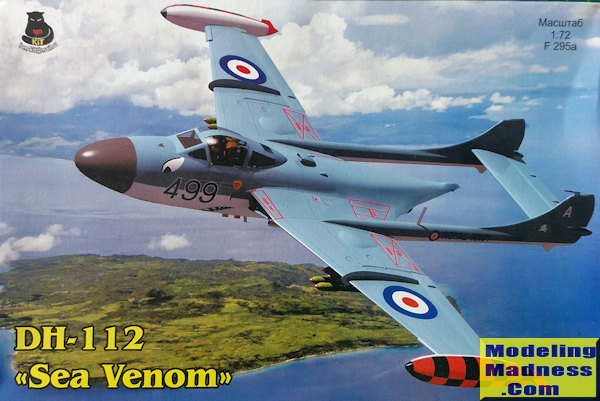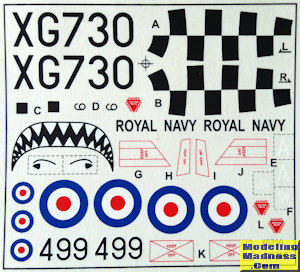
IOM 1/72 deHavilland Sea Venom
| KIT #: | F295a |
| PRICE: | 1600 yen |
| DECALS: | One option |
| REVIEWER: | Richard F |
| NOTES: | Repopped Frog kit |

| HISTORY |
De Havilland’s Sea Venom was the naval version of the Venom night fighter (there was also a single seater day fighter without radar). The Sea Venom packed four 20mm cannon and a radar operated by the second crew member. Later on, they were modified to fire the Firestreak missile, made by the same company and more commonly associated with the Lightning. That missile was never a stellar performer, even compared to contemporaries in the era of poor-performing early air to air missiles. It was a heatseeker that could fly at Mach 3 for about six kilometers, strictly in a tail-chase mode.
The French had a licence-built version of this plane, called the Aquilon, and the Royal Australian Navy flew Sea Venoms off HMAS Melbourne until 1967 when they were replaced with Skyhawks.
In Royal Navy service, Sea Venoms flew off large and small carriers until about 1960 when the much bigger and more capable Sea Vixen entered service. Sea Venoms operating off HMS Albion and HMS Eagle flew ground attack sorties during British operations over Suez in 1956, and again from HMS Albion during the “Cyprus Emergency” in 1958.
| THE KIT |
 This kit was originally made by Frog. When I was a teen in the 1980s Frog kits
were already unavailable but there was a healthy trade in them at the club I
attended. People seemed to like them as reasonably accurate models of aircraft
you couldn’t necessarily get in Airfix or Matchbox which were just about the
only other available brands where I lived, at least within my budget. Of course,
in those days we all had different standards, and by today’s expectations these
kits are hopelessly primitive. Still, I look at Frog with quite a bit of respect
and to be very honest, every modeller with a few kits under his or her belt
ought to give a Frog kit a try, if only to see how it used to be done. In
general, and especially if it’s a modern re-pop with decent decals, a Frog kit
just requires the Three Ps: patience, putty and perseverance.
This kit was originally made by Frog. When I was a teen in the 1980s Frog kits
were already unavailable but there was a healthy trade in them at the club I
attended. People seemed to like them as reasonably accurate models of aircraft
you couldn’t necessarily get in Airfix or Matchbox which were just about the
only other available brands where I lived, at least within my budget. Of course,
in those days we all had different standards, and by today’s expectations these
kits are hopelessly primitive. Still, I look at Frog with quite a bit of respect
and to be very honest, every modeller with a few kits under his or her belt
ought to give a Frog kit a try, if only to see how it used to be done. In
general, and especially if it’s a modern re-pop with decent decals, a Frog kit
just requires the Three Ps: patience, putty and perseverance.
IOM-Kit is a Russian company that seems to have acquired, or acquired access to,
the Frog moulds. I’m sure out there in internet land someone knows more about it
than I could find out.
Anyway, I always wondered, when attending a club meet as a teen, what the hell
"flash" was, and why everyone went on about it. Well, now I know. It's the stuff
you see everywhere on this kit - plastic that has seeped out of the mould
leaving big chunks of very thin stuff you'll have to remove. (Editor's
note: While an initial look at the sprues shows a lot of flash, a closer look
finds the actual parts to be pretty much flash fr ee
and the majority of the flash on the sprues themselves. Sure, a few bits have
flash (like the canopy and fuselage half, but by and large, the kit is pretty
clean for something of this vintage.)
ee
and the majority of the flash on the sprues themselves. Sure, a few bits have
flash (like the canopy and fuselage half, but by and large, the kit is pretty
clean for something of this vintage.)
Once you're done with all that clean-up, you're looking at a pretty basic kit.
There are two basic seats, two even more basic aircrew, and the rest of the
detail is impossibly soft by today's standards. The canopy is really thick, and
not very clear (it has a kind of a yellow hue). For stores, there are a pair of
twin-pack rockets under each wing, for a total of eight rockets.
The decal sheet looks nicely done but it's anyone's guess how they will actually perform.
| CONCLUSIONS |
Well, it's a cool plane, but let's not beat around the bush. This one is a throwback and as they say in the classics, "modelling skills required". Still, with a bit of patient putty and sanding, there's no reason this can't look nice. The alternative, of course, is the much newer Dragon offering, which didn't come with entirely glowing reviews and, where I live, is more than four times the price.
If you happen to be entering a certain Frog Contest any time soon, this might be a great choice!
July 2016
Copyright ModelingMadness.com
If you would like your product reviewed fairly and fairly quickly, please contact the editor or see other details in the Note to Contributors.